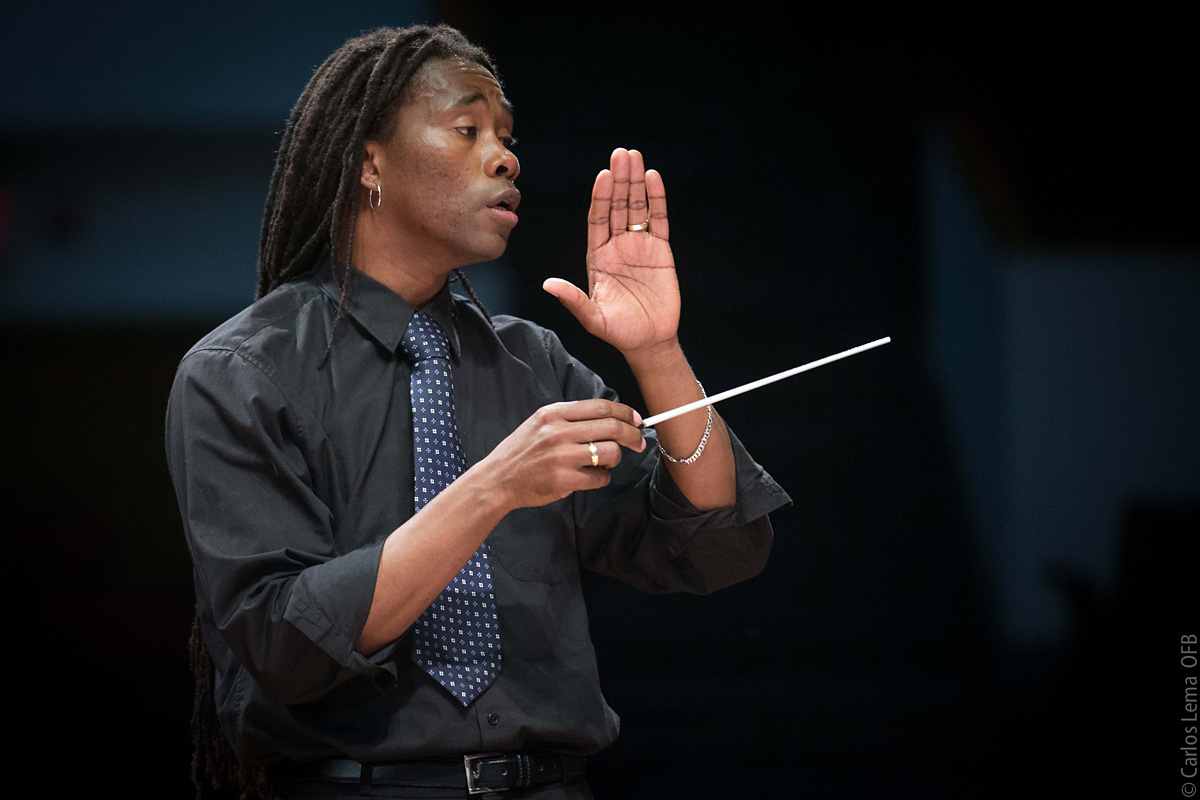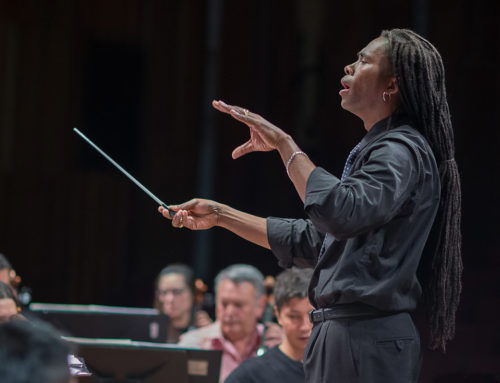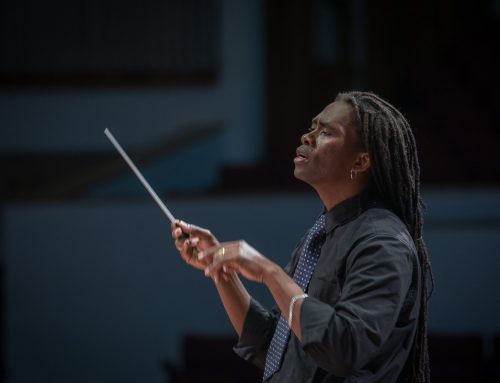Conducting a performance of music necessitates from the conductor a degree of memorization of the music. The amount of music any conductor must learn for every performance, requires that most of it, to a degree, has to be memorized consciously or unconsciously, even when conducted from the printed music. In other words, any piece of music intended to be performed in a concert has to be memorized to a certain extent as result of the learning process itself.
Leading a performance without the printed music is what is called conducting from memory or conducting by heart. By definition, conducting from memory
is the ability to lead the musical ensemble without either a music stand or the score.
There are different types of memories involved in conducting. These are aural, visual, muscle, emotional, structural and spatial memories. All of them are closely related to the learning process and the performance.
The key to memorizing a music score is based “sequential associations”. Although, it would be interesting to investigate how the brain executes these sequential associations, that would be a matter for a different paper.
The practice of leading an ensemble without the presence of the printed music took a while to become established. At the end of eighteenth century conductors such as Hans Richter (1843-1916), Gustav Mahler (1860-1911) and Richard Strauss (1864-1949) used to conduct from the score, even their own compositions. Nevertheless, Richard Wagner (1813-1883) and Hans von Bülow (1830-1894) created a great impression by conducting entire programs by heart. Later, Arturo Toscanini (1867 – 1957) became well known for the extraordinary
number of scores he conducted from memory, both in rehearsal and performance.
Most conductors of the orchestras in America in the twentieth century such as Kousevitzky, Monteux, Ormandy, Munch and Mitropoulos directed every performance from memory. Also, the most eminent conductors in Europe during the twentieth century did so, Fürtwangler, Klemperer, Walter among others. Figures such as Barbirolli, Böhm and the two most influential conductors of the late twentieth century, Karajan and Bernstein also used to conduct their performances from memory. However, some other conductors did not apply this practice. Stokowski as well as Golschmann conducted even well know repertoire from the score.
Currently, conductors all around the globe conduct entire performances, even the most demanding repertoire, without printed music, Abbado, Mehta and Rattle among others.
Clara Schumann (1819-1896) felt that playing by heart “gave her wings power to soar”. Although, there are some reluctant conductors who consider it unnecessary, arguing that if they know how to read music why should it be necessity to conduct without it. Also, they feel, having the score creates confidence for the orchestra as well as the conductor. As a matter of fact, there are a number of conductors who disagree with performing by heart, claiming that no one should conduct or perform from memory until they are capable of writing down the entire score from memory. However, some claim that being free from the printed music enables them to have more space for expressiveness, and enhances the communication with the ensemble. This enhancement comes from being less focused on the printed score, and more connected with the players.
Memorising a piece is the result of an efficient learning process. This process is a compound of unconscious connections and associations that go beyond the music itself. Various types of memories interact in order to build a solid musical memory-structure.
The skill of memorizing an entire four movement symphony for instance, or an opera does not come automatically. It requires training and thorough preparation. Therefore, it is important to understand how the memory functions as well as how it enhances the ability to memorize in a faster way.
In order to understand how the memory of a conductor works it is important to know the different types of memories that are involved. All of them are nourished and strengthened by methodical study, and a thorough discipline which aims to be prepare the conductor to lead any performance or rehearsal from the heart.
Aural memory (auditory): This type of memory enables the conductor to recognize tunes and even pitches with accuracy. Having the music in the head provides information concerning what is coming next, allowing conductor to anticipate the next cue.
Visual memory (vision): Also known as photographic memory. This kind of memory visualizes the whole score in the conductor’s head while performing it.
Some conductors are known by their impressive photographic memory. However, others admit they do not trust it at all. This might be because of the fear of memory lapses that could occur during the performance.
Muscle memory (motor, physical): also named kinaesthetic memory. This type of memory is responsible for instinctive motion. It implies execution of complex movements in an accurate manner without conscious thought. Once learned muscle memory becomes an unconscious process. Choreographers and ballet dancers use this type of memory-skill to accomplish the most sophisticated and on-going movement in their performances. In a similar sense, a conductor, while learning the score, translates the music into an expressive flow of movement.
Conducting technique encompasses a wide range of movement that has to be memorized, so the conductor is able to execute without any hesitation all kind of gestures during the performance. Also, this type of memory is in charge of the synchronization of different tasks such as cues, dynamic indications, cut off points and even pitch control. All of which need to be done in a split second.
Emotional memory: Feelings and emotions relating to information and events occurring during the composition and the composer’s life enrich the performance of the conductor. Varied sources, such as biographies, histories, letter, memoires and material relating to the composition itself, can provide elements which support a conductor’s vision of the music. Consequently, this sort of memory enhances the interpretation of the piece, portraying musical ideas intimately associated with the emotions and feelings inherent in the composition.
Structural memory (analytical): This sort of memory is based on the understanding of the organization of the piece in terms of its form. It is achieved by a conscious analytical approach of the piece. For practical purposes conductors analyse the works in order to achieve certain depths in their understanding. After motion memory, structural memory is the most useful as it continually captures information from the score.
Space memory (spatial): This type of memory connects the location of the ensemble to the conductor’s position, with the parts as printed in the orchestra score. Concert halls and even opera theatres require particular layouts for the
orchestra, as do certain programs. Sometimes composers require particular orchestral settings. For instance, in opera scores the soloists and the chorus are placed in the middle of the string section. In a concert work as soloist is placed at the top of the string section. All these variations affect the attention of the conductor.
All these types of memories work together in creating what can be called “associative chaining”. This means, every single detail in the music is consciously associated with the overall and all other details. This allows the conductor to be conscious of the present event as well as its place in the whole. These sequential associations require a conscious approach, therefore, once a conductor is aware of an efficient study method, involving a thorough discipline in training all these kind of memories, then he or she should be capable of leading a performance from memory without any problem. With such depth of knowledge, the printed music becomes little more than stage decoration.
List of reference:
Chaffin, R., Logan, T. R. and Begosh K. T. (year). Performing from memory. Chapter 33.
Colles, M. E. ( 1933). Playing from Memory. The Musical Times. Vol. 74, No. 1086. pp. 718-719.
Galkin, E. W. (1988). A History of Orchestral Conducting: In Theory and Practice. (city): Pendragon.
Jäncke, L. (2008). Music, memory and emotion. Journal of Biology. 7:21.
McElheran, B. (2004). Conducting Technique: For Beginners and Professionals. New York: Oxford.
Palmer, C. (2005). Sequence Memory in Music Performance. Current Directions in Psychological Science, Vol. 14, No. 5. pp. 247-250.
Rink, J. (2002). Musical Performance: A Guide to Understanding. Cambridge. Cambridge University Press.





Leave A Comment